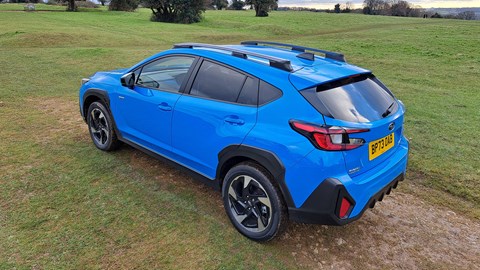► It’s a new Subaru! To a fashion, anyway
► Subaru Crosstrek facelifts the XV
► Plus, there’s some new technology inside
The Subaru XV has been around for a long time, now. It hit the UK market in 2017 – and Subaru’s reluctance to give the car a comprehensive update in that time meant it was starting to feel a little long in the tooth compared to newer rivals such as the Ford Puma and Renault Austral.
But Subaru has finally recognised this – and it hopes a swathe of updates ushered in with the rebranded Subaru Crosstrek will drag the XV back into the family SUV race.
The firm has given the SUV a thorough styling overhaul, loaded it with some fresh technology and dropped the car’s XV branding in favour of the new ‘Crosstrek’ nameplate.

The revised and rebadged Subaru Crosstrek is available to order in the UK now. Prices start from £34,290 for the most basic Limited specification, which makes it around £6000 more expensive than the most basic Skoda Karoq. However, Subaru justifies the added expense by offering the Crosstrek with more equipment and a hybrid powertrain as standard.
So, what’s changed between the XV and the new Subaru Crosstrek?
Quite a lot. There are new front and rear bumpers, slimmer LED headlights and extra body cladding that extends further up the car’s flanks. The entry-level Crosstrek also comes with a fresh set of 17-inch alloy wheels as standard, while the range-topping Touring model features 18-inch alloys.
Subaru has made some aerodynamic improvements, too. There are new air outlets on the trailing edge of the front wheelarches, which the company says allows turbulent air to escape from the arches, helping to reduce front-end lift and improve stability. There are similar outlets on either side of the rear bumper that are designed to reduce body sway by releasing the air pressure that would otherwise get trapped behind the panel.

The changes continue inside. The 2024 Subaru Crosstrek’s dashboard and interior trims will be familiar to XV owners, but Subaru has made a few targeted upgrades that it says make the Crosstrek easier to live with. The biggest changes are some extra sound deadening and a new front seat design that Subaru says makes the car more comfortable over long distances.
There’s also a new 11.6-inch portrait infotainment system, with support for wireless Apple CarPlay and Android Auto. However, the larger screen occupies more space on the dashboard, eating into the space that was previously occupied by the climate control panel. That means the car’s physical knobs and dials have been replaced by a new climate control menu on the touchscreen.
Any changes to the mechanicals?
Like the XV, the Crosstrek is powered by one of Subaru’s 2.0-litre four-cylinder mild-hybrid boxer engines – but the new car’s engine is less powerful than the one it replaces. It produces 134bhp and 134lb ft of torque, compared to the 148bhp and 192lb ft you got in the old XV.
Subaru says the Crosstrek has a 0–62mph time of 10.8 seconds and a top speed of 123mph. As before, the engine sends drive to all four wheels through a continuously variable transmission (CVT). The range-topping Touring model also has a feature that allows the driver to cycle through eight fixed gear ratios using a pair of paddles mounted behind the steering wheel.

Subaru is really leaning into its rugged branding with the Crosstrek. Every version of the car is fitted with hill descent control and an off-road driving setting called X-Mode, which adjusts the car’s throttle response, gearing and stability control system to make the car easier to pedal over rough terrain. Touring models also feature hill start assist and a further two driving modes, called Intelligent and Sport.
Anything else I should know?
Every version of the Crosstrek is fitted with the latest version of Subaru’s Eyesight Driver Assistance Technology. The company says the revised safety suite has a wider field of view and improved software, allowing it to recognise pedestrians and bicycles sooner. The technology also now notifies the driver of any hazards faster and, if necessary, will apply the brakes to avoid an accident.
Other standard safety equipment includes automatic emergency steering, blindspot monitoring, lane-keeping assist and rear cross-traffic alert. Plus, there’s an interior monitoring system that’ll issue the driver with a warning if it recognises they’re distracted or fatigued behind the wheel.